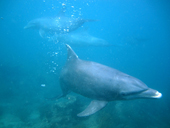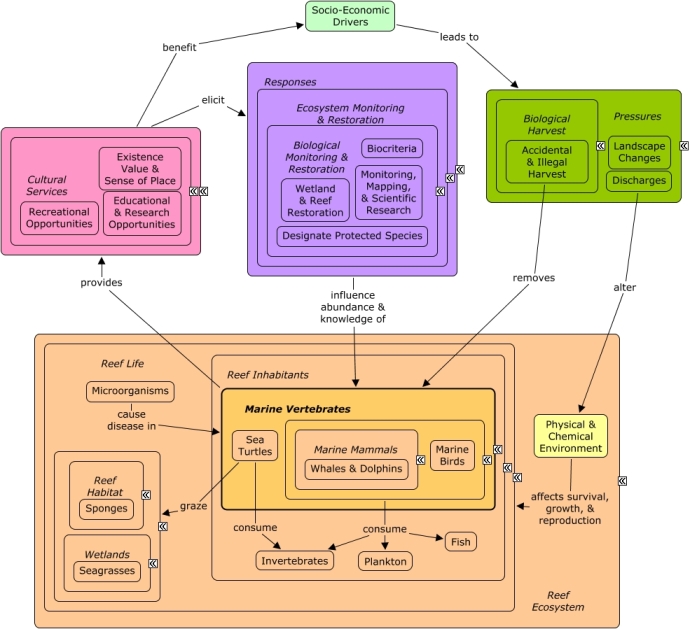ReefLink Database

Whales & Dolphins
Whales & Dolphins are marine mammals of the order cetacea
CMap

CMap Description
Whales & dolphins are most notable for their contribution to aesthetic & recreational value; but are also significant contributors to existence value, sense of place, and the educational & research value of coral reef ecosystems. Whales & dolphins consume fish, invertebrates, and plankton. Whale & dolphin populations are threatened by pressures created by socio-economic drivers. Accidental & illegal harvest, disease-causing microorganisms, and a disturbed physical & chemical environment will stress or kill whales & dolphins. Biological monitoring & restoration is essential in identifying changes in the abundance and condition of whales & dolphins; as well as determining appropriate responses to maintain the supply of ecosystem services and ensure the benefits to human health and well-being.Citations
More than 50 citations. Click here to load.
| Citation | Year | Study Location | Study Type | Database Topics |
|---|
Management Options
| Management Option | Description | Sources | Database Topics |
|---|---|---|---|
| Corporate Response: Standardized Environmental Certifications and Labels | Product labeling initiatives are based on the premise that product information represented by or contained on the label is otherwise not readily available (or apparent) and is of value in consumer purchase decisions. For example, warning labels highlight product safety and toxic exposure hazards and advise consumers on ways to minimize risks. Likewise, a number of environmental certification programs (ECPs) identify products' environmental burdens and/or set standards for products' environmental attributes. Properly designed environmental labeling efforts can change consumer and manufacturer attitudes and behaviors, thus reducing environmental burdens. The specific metrics used to measure environmental label effectiveness include: 1) consumer awareness of labels, 2) consumer acceptance of labels (credibility and understanding), 3) changes in consumer behavior, 4) changes in manufacturer behavior, and 5) improvement of end goals, such as environmental quality. | Malcohn, E., Bentham Paulos, Andrew Stoeckle, Herbert Han-Pu Wang, and Julie Lynch. Determinants of Effectiveness for Environmental Certification and Labeling Programs. EPA-742-R-94-001, US EPA, Washington, DC. |
Agriculture; Agriculture, Aquaculture, & Forestry Policies; Aquaculture; Banks, Credit, & Securities; Climate; CO2; Collaboration & Partnering; Commercial Fisheries; Corporate Responses; Economic Markets & Policies; Environmental Education & Outreach; Fishing Sector; Food & Energy Policies; Food, Beverage, & Tobacco Products; Forestry; Health; Manufacturing & Trade; Manufacturing & Trade Policies; Marine Birds; Medical Care; Medical Centers; Metals, Electronics, & Machinery Products; Resource Use Management; Toxics; Transportation; Utilities; Whales & Dolphins; Wholesale & Retail Trade; Wood, Plastics, & Chemical Products |
| Monitor & Research: Biological Status and Trends Monitoring | This activity produces long-term comprehensive information on sanctuary-wide status and trends of biological resources. Data that could be collected on coral reef communities includes but is not limited to species abundance and density, biodiversity, benthic cover, coral condition, growth, recruitment, predation, and grazing. Mangroves and seagrasses should also be monitored. With adequate baseline data, changes in community structure and biocriteria can be identified and restoration or protection efforts can be taken. | NOAA Marine Sanctuary Program. 2007. Florida Keys National Marine Sanctuary revised management plan. National Ocean Service, Key West, FL. |
Algae; Anemones & Zooanthids; Apex Fish Predators; Aquaculture; Aquarium Stock; Biochemical & Genetic Resources; Biocriteria; Biological Harvest; Biological Monitoring & Restoration; Biological Monitoring, Mapping, & Scientific Research; Bivalves; Calcareous Macroalgae; Contact Uses; Coral; Coralline Algae; Cyanobacteria; Decision Support; Echinoderms; Ecosystem Monitoring & Restoration; Finfish & Shellfish Stock; Fish; Fishing Sector; Food & Energy Policies; Hydrocoral; Invasive Species; Invertebrates; Large Herbivorous Fish; Lobster, Crab, & Shrimp; Mangroves; Marine Birds; Marine Products; Marine Vertebrates; Marine Worms; Microorganisms; Molluscs; Octocoral; Octopus & Squid; Ornamental Jewelry & Art; Pathogens; Pharmaceuticals & Cosmetics Sources; Physical Damage; Primary Production; Provisioning Services; Resource Use Management; Sea Turtles; Sea Urchins; Seagrasses; Seastars; Skeletal Coral; Small Herbivorous Fish; Snails & Conch; Sponges; Stony Coral; Tunicates; Wetlands; Whales & Dolphins |
| Public Participation: Assist Dolphin Ecology Project | This volunteer program photographs individual dolphins for identification, observes the activities of the dolphins, samples environmental parameters, and identifies and measures the abundance of important dolphin prey. | NOAA Marine Sanctuary Program. 2007. Florida Keys National Marine Sanctuary revised management plan. National Ocean Service, Key West, FL. |
Collaboration & Partnering; Environmental Education & Outreach; Environmental Monitoring & Restoration; Environmental Monitoring, Mapping, & Scientific Research; Fish; Marine Vertebrates; Physical & Chemical Environment; Reef Inhabitants; Reef Life; Scientific Research; Security & Public Administration Policies; Whales & Dolphins |
Laws
| Legal Citation | Purpose of Law | Management Organization | Database Topics |
|---|---|---|---|
| Marine Mammal Protection Act of 1972, 16 United States Code § 1361. | With certain exceptions, the Act establishes a mortiorium on the taking and importation of marine mammals, as well as products that are made from them. DOI is responsible for sea otter, walrus, polar bear, diugong and manatee. The DOC is responsible for Cretaceans and piniped other than the walrus. Application to Coral Reefs: Legislative Actions:The legislation mandated the use of an ecosystem-based management approach to marine resource management. The Marine Mammal Commission was established and has specific advisory and research duties. Required that government observers aboard some fishing vessels. Comments:The Act covers all species of marine mammals and plants, including anadromous fish, except for marine ammmals, birds, and highly migratory species, all of which are covered under other laws or treaties. |
National Oceanic and Atmospheric Administration/National Marine Fisheries Service Jurisdiction: United States |
Designate Protected Species; Environmental Monitoring, Mapping, & Scientific Research; Fishing & Harvesting Management; Political Pressure; Public Administration; Reef Inhabitants; Reef Life; Resource Use Management; Whales & Dolphins |
| Marine Mammals, 50 Code of Federal Regulations. | The regulations prohibit the capture of marine mammals on land or sea in US waters and prohibits the improtation of any marine mammal product to the US (CFR 216.11-216.12) unless the person has a permit for scientific purposes (CFR 216.33-216.37). Application to Coral Reefs: Legislative Actions: Comments: |
National Oceanic Aatmospheric Administration/National Marine Fisheries Service Jurisdiction: US Federal Waters; Designated Marine Areas |
Commercial Fisheries; Designate Protected Species; Designated Uses; Fishing & Harvesting Management; Political Pressure; Recreational Fishing; Resource Use Management; Whales & Dolphins |
| Surface waters of the State, Florida Administrative Code Annotated §§ Chapter 62-301 (1996). | It is the intent of this Chapter to define the landward externt of surface waters of the state. Te findings, declarations, and intentfor this Chapter are the same as those for Chapter 62-302 F. A. C. Application to Coral Reefs:By defining the landward extent of surface waters of the State using dominant plant species, the guidance in the Chapter will include wetlands and transitional zones on many occasions. Through the protection of these areas, filtration of sediment and nutrients will be maintained and two of the harmful parameters for coral reefs will be reduced. Legislative Actions:The Chapter is a guidance document and does not contain penalties. The Chapter provides a list of plant species for use with the guidance as well as the methods of calculating the areas of state waters. Comments: |
Florida Department of Environmental Protection Jurisdiction: State Coastal Waters; US State Waters; Designated Marine Areas |
Arthropods; Ballast Discharge; Beaches & Nature Parks; Biotechnology Research & Development; Building & Home Construction; Coastal Development; Docks & Marinas; Dredging Regulations; Dredging, Draining, & Filling; Finfish & Shellfish Stock; Fish; Fishing & Harvesting Management; Forestry; Invertebrates; Landscape Conservation & Restoration; Landuse Management; Mangroves; Marine Birds; Marine Vertebrates; Molluscs; Non-point Source Runoff; Nutrient & Contaminant Processing; Petroleum Spills; Pipelines; Ports & Harbors; Recreational Fishing; Resource Use Management; Sea Turtles; Seagrasses; Sediment; Shoreline Armoring; Small Boats; Surface & Groundwater Flow; Utility Line Construction & Maintenance; Wastewater Discharge; Wetlands; Whales & Dolphins |
